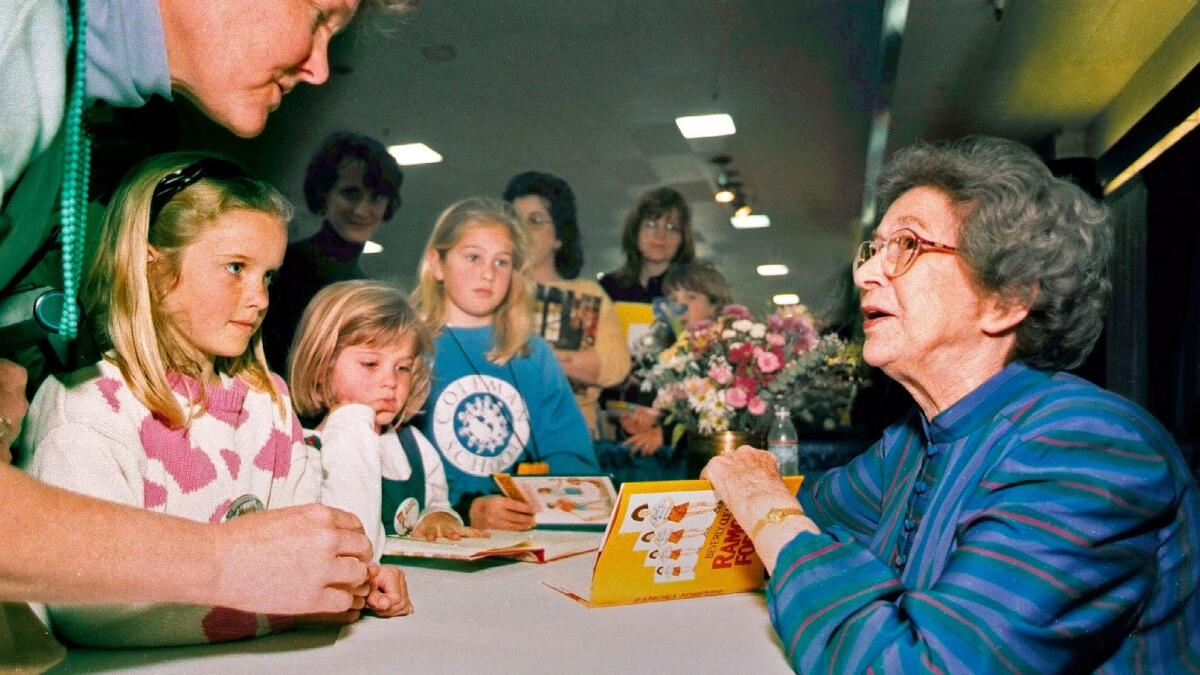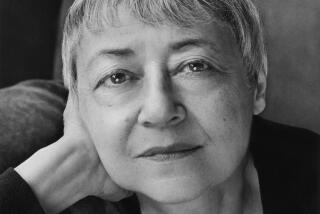Beverly Cleary, beloved and prolific author of children’s books, dies at 104

- Share via
With witty yet economic prose and a gift for recalling the inner emotions of childhood, Beverly Cleary wove timeless tales that took young readers back to the Portland, Ore., of her youth.
Her stories served as a collective touchstone for the childhoods of many baby boomers, and succeeding generations, who saw themselves in the pages of her work.
Cleary died Thursday in Carmel, where she had lived since the 1960s. She was 104.
The grande dame of children’s literature, she wrote both humorously and realistically about the anxieties of childhood in such enduringly popular books as “Henry Huggins” and “Beezus and Ramona.”
A former children’s librarian, Cleary became one of the most popular authors of American children’s books, penning more than 30 titles over five decades that sold 85 million copies around the world.
More than a decade ago, the Library of Congress declared Cleary a living legend, and her birthday, April 12, is celebrated with Drop Everything and Read Day, held annually in U.S. libraries and schools.
“She showed me that the inner life of any child, the dynamics of family and pets, can be captured as rich, comic, fascinating, poignant and meaningful,” Susan Patron, a Newbery Medal-winning novelist and former youth services librarian at the Los Angeles Public Library, told The Times in 2011.
Beverly Cleary’s ‘exceptionally happy career’
In 1984, Cleary won the Newbery Medal for a book that was a departure from her usual lighthearted fare, “Dear Mr. Henshaw,” the story of a 10-year-old boy who corresponds with a famous author while his parents divorce. Despite the serious subject, her trademark playfulness was evident from the boy’s first letter: “My teacher read your book about the dog to our class. It was funny. We licked it.”
The idea for the book had literally arrived in the mail, when two boys from different parts of the country asked Cleary to write about divorce.
By then, she had written more than 25 books about what she called “ordinary children” with everyday lives — and in the process changed the landscape of children’s literature.
With the publication of her first book, “Henry Huggins,” in 1950, Cleary began to usher in an era of realistic storytelling for young people more used to morality tales or “reading about children in England,” as she later said.
Her clear-eyed approach influenced many authors who followed, helping “bring a low-key realism to the territory of childhood, highlighting the dramas, large and small, of daily life,” Times book critic David L. Ulin wrote in 2011.
Another highly successful children’s author, Judy Blume, said in a 94th birthday salute to Cleary: “You made me fall off the sofa, laughing. … When I began to write you were my inspiration. You will always be my inspiration.”
Cleary invented one of her most popular characters — the spirited, pesky Ramona Quimby — as an afterthought when she realized that nearly everyone she wrote about was an only child. A typical Cleary creation, Ramona was believable yet invoked giggles. She drove her older sister Beezus crazy and was always getting into jams. Ramona might bake a cake, but she would also mix her favorite doll into the batter. While making a sign to persuade her father to stop smoking, Ramona made a mistake universal to childhood when she misjudged her space and wrote “NOSMO KING.”
Eight Cleary books revolved around the amusingly imperfect heroine, including the last, “Ramona’s World” (1999), in which the fourth-grader marks her “zeroteenth” birthday. “Ramona and Her Father” (1977) and “Ramona Quimby, Age 8” (1981) were named Newbery Honor books, and the series was made into the 2010 movie “Ramona and Beezus.”
The earlier novels “Beezus and Ramona” (1955) and “Ramona the Pest” (1968) were her “twin masterpieces,” writer Bruce Handy declared in 2006 in Vanity Fair: “Imagine if Henry James had drafted episodes of ‘Leave It to Beaver.’ ”
People always assumed she was Ramona, Cleary said, but she asserted that she was far better mannered than her uninhibited creation. The author did, however, admit to having “Ramona-like thoughts!”
Love Beezus and Ramona? Beverly Cleary’s childhood home is for sale
An only child, Cleary was born Beverly Atlee Bunn on April 12, 1916, on her family’s 80-acre farm near McMinnville, Ore.
Hard times forced her parents, Chester and Mable Bunn, to sell the family farm. They moved to Portland when she was 6, and her father went to work in a bank.
“I had a bad time in school in the first grade,” Cleary told The Times in 2011. On the farm, she had been “free and wild,” and it was a shock to be “shut up in a classroom.”
It didn’t help that she found the first-grade reader to be “incredibly stupid.” In third grade, Cleary discovered “The Dutch Twins” by Lucy Fitch Perkins and from that moment on was a reader.
For a sixth-grade assignment about a favorite literary character, Cleary wrote about a girl who visited Bookland and talked to a number of famous figures.
“A feeling of peace came over me as I wrote far beyond the required length,” Cleary recalled in “A Girl From Yamhill,” one of her two memoirs. “I had discovered the pleasure of writing.”
“The teacher said that when I grew up, I should write children’s books,” she recalled in the 2011 Times interview. “So I put that in the back of my mind.”
Her practical mother suggested she have another job that would provide steady income, so Cleary decided to become a librarian.
During the Depression, her father lost his job, just as Ramona’s father would decades later in Cleary’s fiction.
Cleary was able to afford to go away to school by living with a cousin and attending Chaffey College, a community college then in Ontario. She earned pocket money shortening skirts for classmates.
She transferred to UC Berkeley and earned a bachelor’s in English in 1938. At a school dance, she met Clarence Cleary, an accountant and fellow student six years her senior. They married in 1940.
Beverly moved to Seattle to study to be a children’s librarian at the University of Washington and received her degree in 1939. Soon after, she was hired by the public library in Yakima, Wash., and, in an oft-told story, recalled a request that stayed with her: “A grubby little boy” had asked, “Where are the books about kids like us?”
During World War II, Cleary worked as a librarian on an Army base in Oakland.
WE were driving through the gracious old suburbs of Portland, Ore., searching for a cafe that had gotten raves for its seafood, when I looked up from my map and saw a sign that resonated to the core of my bookworm soul: “Klickitat Street.”
In 1948, she and her husband settled in a small home in the Berkeley Hills. When she came upon an unused ream of paper in a closet, Cleary took it as a sign that she should start writing, she later recalled.
“Henry Huggins was in the third grade,” Cleary began. “His hair looked like a scrubbing brush and most of his grown-up front teeth were in. He lived with his mother and father in a square white house on Klickitat Street,” an actual street in Portland near where Cleary had grown up.
“Ribsy” (1964), one of several sequels, unfolded from the perspective of Henry’s “plain ordinary city dog, the kind of dog strangers usually called Mutt or Pooch,” she wrote.
Her twin children, Marianne and Malcolm, were born in 1955; they eventually enriched her writing by bringing home stories from school, she later said.
When Cleary saw Malcolm — her reluctant reader — playing with a toy motorcycle while he was sick, she was inspired to write the 1965 book “The Mouse and the Motorcycle.”
Boys often wrote to tell her that the book, about a reckless mouse with a penchant for adventure, was the first they had ever enjoyed reading, Cleary later said. She wrote two sequels.
Her kid-lit schoolyard also included “Ellen Tebbits” (1951), about a third-grader who is always fighting and making up with her new best friend, and “Otis Spofford” (1953), a prank-loving fourth-grader who meets his match in Ellen.
Cleary did what she set out to do, writing “humorous books” that “made children want to read,” she said more than once. “I’ve had an exceptionally happy career.”
Cleary is survived by her children, Marianne and Malcolm, three grandchildren and a great-grandchild. Her husband died in 2004.
More to Read
Start your day right
Sign up for Essential California for the L.A. Times biggest news, features and recommendations in your inbox six days a week.
You may occasionally receive promotional content from the Los Angeles Times.






